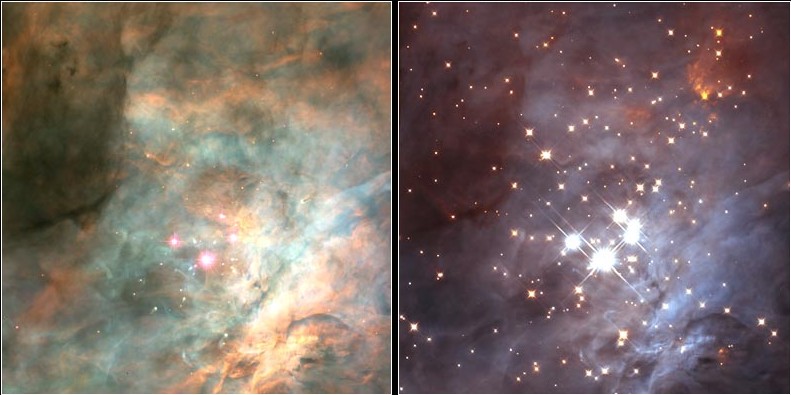The Trapezium Cluster is a young open star cluster located in the centre of the Orion Nebula in the constellation Orion. It is also known as the Orion Trapezium Cluster or Theta-1 Orionis and is a relatively young cluster that has formed directly out of the parent nebula.
The four brightest stars form a trapezoid-shaped asterism from which the cluster gets its name. The five brightest members are found within 1.5 light years of each other and have estimated masses of between 15 and 30 times solar. The young OB stars are luminous X-ray sources and are also responsible for much of the illumination of the surrounding nebula.
The cluster is easy to identify in the sky and can be seen through telescopes. It has an apparent magnitude of 4. The cluster has also been the subject of NASA’s Hubble Space Telescope, which has allowed scientists to understand the cluster better.

Distance, Size and Mass
The Trapezium Cluster is located 1,600 light years away from Earth in the centre of the Orion Nebula (M42). It is a small cluster and occupies only 47 arc seconds of apparent sky.
It is easy to identify in the sky because the brightest four stars form an asterism shaped like a trapezoid, which is where the cluster gets its name. The cluster can be seen in 5-inch telescopes, which reveal six of the cluster’s stars in good conditions.
It is thought that the Trapezium Cluster may be part of the Orion Nebula Cluster, which a much larger grouping of about 2,000 stars that occupy an area roughly 20 light years in diameter. The bright stars of the Trapezium Cluster were formed directly out the surrounding nebula.
The clusters right ascension is 05h 35.4m and its declination is −05° 27′. Its radius is 10 light years and its age is thought to be 3 × 105 years.
Composition and Stars
The massive stars in the Trapezium Cluster’s centre form the asterism after which the cluster is named. They are designated A, B, C, and D.
The brightest and most massive of the trapezium stars is Theta-1 Orionis C. It has a visual magnitude of 5.13 and the stellar classification O6pe V. It also has an absolute magnitude of -3.2 and is 251,000 times more luminous than the Sun. This makes it one of the most luminous stars known. It was revealed to be a close binary system exhibiting optical variability in an infrared survey. It is also one of the nearest O-type stars to the Solar System.
Theta-1 Orionis A, also known as V1016 Orionis, and Theta-1 Orionis B, or BM Orionis, have been identified as Algol-type eclipsing binaries. These are double stars that orbit and eclipse each other when observed from Earth. Theta-1 Orionis A varies between magnitudes 6.73 and 7.53 every 65.4325 days. Theta-1 Orionis B varies between magnitudes 7.95 and 8.52 with a period of 6.4705 days. Component B is the faintest of the four stars that form the Trapezium.
About half the young stars within the cluster have been found to contain evaporating circumstellar disks. This is a likely precursor to planetary formation. The cluster is also home to a significant number of brown dwarfs. These are substellar objects that don’t have enough mass to sustain hydrogen fusion in their cores. As well as low-mass runaway stars, members moving away from cluster at a relatively high velocity.
In 2012, a black hole was possibly discovered in the cluster. It may have a mass of more than 100 solar masses and its existence would explain the large velocity dispersion of the cluster’s members.
Formation
The Trapezium Cluster was discovered by the Italian astronomer and mathematician Galileo Galilei, who sketched three of the cluster’s stars, but did not see the surrounding nebulosity.
Dutch scientist and mathematician Christiaan Huygens independently discovered the three stars designated A, C and D in 1656. The fourth member, B, was discovered by the French astronomer Jean Picard in 1673, completing the Trapezium. Huygens himself observed the fourth component in 1684.
More stars were discovered in 1673 and, by 1888, a total of eight members were known. A few of the stars were later discovered to be binaries.
Image Sources:
- https://en.wikipedia.org/wiki/Trapezium_Cluster#/media/File:Trapezium_cluster_optical_and_infrared_comparison.jpg